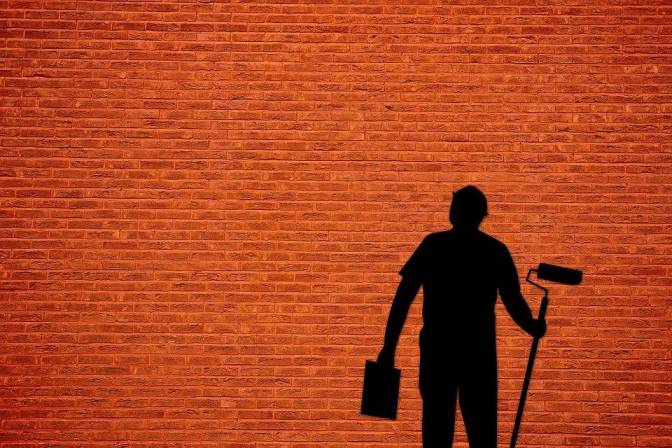Many people are familiar with the fundamentals of painting preparation. They understand the need to use drop cloths, painter's tape, and properly stirring paint. But did you also know that using a golf ball to maintain paint quality or microwaving paint tape to make it more workable can help?
Knowing a few more painting methods will help you get the best results with most DIY related tasks. You can avoid imperfections and cover surfaces evenly by properly storing paint and then using the correct equipment.
Suppose you're ready to sell, altering your décor, or performing regular home repairs. In that case, these nine DIY painting techniques will help you enhance the efficiency of the project while saving time and money.

Flaws should be sanded away
You should start with a completely flat surface to apply a flawlessly smooth layer to ceilings, walls, and woodwork. Because they spend a lot of time pressing sandpaper, one pro suggested that Sander might be a better work title than Painter.
Sanding painted wood trim, like baseboard moldings and door and window casings, eliminates burrs and rough areas. Using fine-grit sandpaper to roughen a shiny painted surface enables the fresh layer to stick more easily.
Consider high-quality supplies
Don't skimp on supplies. Brushes that are too cheap are a waste of money. Buy the nicest brushes you can find, wash them well, and your brushes will last a lifetime. It'll appear like you splattered it on the wall with a rake using a $3 plastic brush. The bristles will then fall into the paint.
It's also critical to choose the highest-quality paint you can buy. It'll be easy to apply, provide excellent coverage, and be durable for many years. You'll also be able to remove smudged fingerprints without removing the paint. And the entire painting project will be completed faster and simpler, with a superior end result.
Make sure to cover your furniture
If you're painting a room, don't bother removing all of the furnishings. Just imagine how much time that will take. Instead, arrange all of the furniture in the room's middle and wrap it with a plastic cover taped at the base. This will shield the furniture from splotches and drips, as well as sanding dust.
Apply a tinted primer
A joint compound is used to repair gaps and patch cracks well before pros start on the walls. However, if you paint straight over the patched areas, the solution will absorb moisture from it, leaving it flat and dull; this is known as "flashing." And those areas will have a distinct appearance from the remainder of the wall. It's critical to prime the walls first to prevent seeing patched spots through the final layer.
Pros, on the other hand, use white tint priming with a little gray paint or the shade of the final paint rather than using it straight from the container. Tinted primer conceals patched areas and hides the original paint color better than a plain primer.
Consequently, the final coat will become more vivid, and fewer applications may be required. That's also particularly true when repainting over bright colors such as orange or red, which may require 3 or more finish layers if a tinted primer isn't used beforehand.
Brushes and rollers should not be washed
If you're working with latex paint, there's no need to wash your rollers or brushes if you're not finished in one day. Since it does not dry fast in cold conditions, wrap your tools in plastic bags place them in the fridge. (Be sure to let them warm up completely before using them.)
Take care of the faulty tape
When using older tape, peeling it off the roll without ripping or adhering might be challenging. Microwave the entire roll of painter's tape for ten seconds if it still peels. Read more on this page.
Determine the type of paint that is currently on the walls
Are you unsure whether the paint on a wall is latex or oil? Dip a cotton ball in alcohol and find a smaller area to wipe on the wall. It's latex if there are paint remains on the cotton ball. Perhaps you haven’t spotted any remains? If that’s the outcome, you'll be repainting over oil-based paint, and you'll need to apply an oil-based primer first.
Consider canvas drop cloths
Professional painters don't use old pillowcases as drop cloths, and you shouldn't either. Droplets and spills will soak through thin sheets and onto your floors. It will be much more difficult to clean them that way.
Also, avoid using plastic sheeting. Although plastic does keep spills contained, the paint remains wet for much too long. If you accidentally step on the plastic, you can ruin your shoes and spread paint all over the floors. What’s worse, if you slip on it, you can fall and break something.
Canvas drop cloths are what the pros generally use. Canvas is costlier, but it's non-slip, soaks up splatters, and can last a very long time. You don't need an enormous drop cloth to cover the entire area unless you're repainting the ceiling in every room of the house. A few feet wide canvas fabric that spans the length of the wall is perfect for shielding the floor.
Conclusion
In situations like these, most homeowners turn to professional painters. If you want the outcome to be perfect, you should consider them as well. Be sure to check out Tex Painting in Austin services, among others, to find out more.
This can be an interesting project for you if you are willing to take the time and effort to do it. But, it will definitely take some time, and it requires precious and skill.
Look for options online, and check other customers’ recommendations and reviews of particular businesses. The more you learn, the faster you’ll be able to make a choice. So good luck with your search for professionals!
